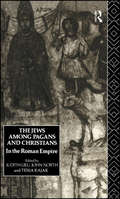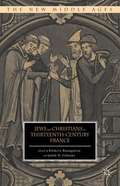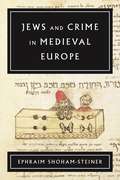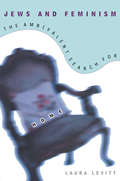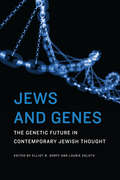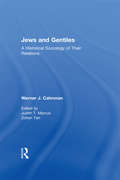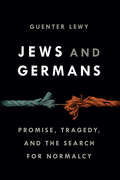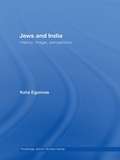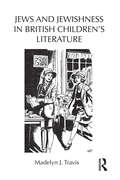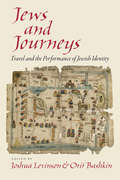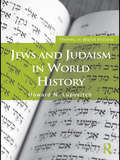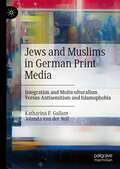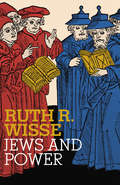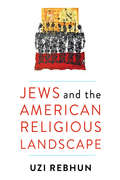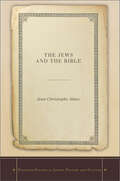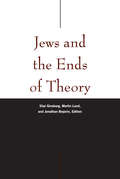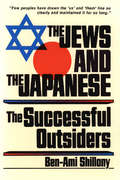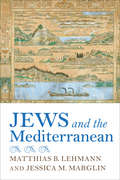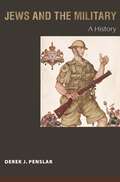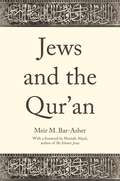- Table View
- List View
The Jews Among Pagans and Christians in the Roman Empire
by John North Judith Lieu Tessa RajakIn the period of Roman domination there were communities of Jews, some still in Palestine, some dispersed in and around the Roman Empire; they had to face at first the world-wide power of the pagan Romans and later on the emergence of Christianity as an Empire-wide religion. How they coped with these dramatic changes and how they influenced the new forms of religious life that emerged in this period provide the main themes of The Jews Among Pagans and Christians. Essays by the leading scholars in the field together with the introduction by the editors, offer new approaches to understanding the role of Judaism and the pattern of religious interaction characteristic of the period.
Jews and Christians in Thirteenth-Century France
by Elisheva Baumgarten Judah D. GalinskyIn light of the growing tendency to view both religious communities as intimately linked, this work seeks to examine a variety of perspectives on Jewish and Christian life in northern France during the thirteenth-century. Contributors investigate the social and cultural changes which took place in European medieval society through legal developments, religious polemic, gender, social history, perceptions of the 'other,' language, literature and art. A secondary, but no less important goal,of this collection is to break down the artificial boundaries that divide the various academic disciplines and those that separate 'medieval studies' from 'Jewish studies'.
Jews and Crime in Medieval Europe
by Ephraim Shoham-SteinerJews and Crime in Medieval Europe is a topic laced by prejudice on one hand and apologetics on the other. Beginning in the Middle Ages, Jews were often portrayed as criminals driven by greed. While these accusations were, for the most part, unfounded, in other cases criminal accusations against Jews were not altogether baseless. Drawing on a variety of legal, liturgical, literary, and archival sources, Ephraim Shoham-Steiner examines the reasons for the involvement in crime, the social profile of Jews who performed crimes, and the ways and mechanisms employed by the legal and communal body to deal with Jewish criminals and with crimes committed by Jews. A society’s attitude toward individuals identified as criminals—by others or themselves—can serve as a window into that society’s mores and provide insight into how transgressors understood themselves and society’s attitudes toward them. The book is divided into three main sections. In the first section, Shoham-Steiner examines theft and crimes of a financial nature. In the second section, he discusses physical violence and murder, most importantly among Jews but also incidents when Jews attacked others and cases in which Jews asked non-Jews to commit violence against fellow Jews. In the third section, Shoham-Steiner approaches the role of women in crime and explores the gender differences, surveying the nature of the crimes involving women both as perpetrators and as victims, as well as the reaction to their involvement in criminal activities among medieval European Jews. While the study of crime and social attitudes toward criminals is firmly established in the social sciences, the history of crime and of social attitudes toward crime and criminals is relatively new, especially in the field of medieval studies and all the more so in medieval Jewish studies. Jews and Crime in Medieval Europe blazes a new path for unearthing daily life history from extremely recalcitrant sources. The intended readership goes beyond scholars and students of medieval Jewish studies, medieval European history, and crime in pre-modern society.
Jews and Feminism: The Ambivalent Search for Home
by Laura LevittBy interrogating America's promise of a home for Jews as citizens of the liberal state, Jews and Feminism questions the very terms of this social "contract". Maintaining that Jews, women, and Jewish women are not necessarily secure within this construction of the state, Laura Levitt links this contractual construction of belonging and acceptance to legacies of marriage as a contractual home for Jewish women. Exploring the immigration of Jews from Eastern Europe for America, as well as their desire to make this country their permanent home, Levitt raises questions about the search for stability in specific Jewish religious and cultural traditions which is linked to the liberal academy as well as feminist study, thus offering an account of an ambivalent Jewish feminist embrace of America as home.
Jews and Genes: The Genetic Future in Contemporary Jewish Thought
by Rabbi Elliot N. Dorff Dr Laurie ZolothWell aware of Jews having once been the victims of Nazi eugenics policies, many Jews today have an ambivalent attitude toward new genetics and are understandably wary of genetic forms of identity and intervention. At the same time, the Jewish tradition is strongly committed to medical research designed to prevent or cure diseases. Jews and Genes explores this tension against the backdrop of various important developments in genetics and bioethics—new advances in stem cell research; genetic mapping, identity, testing, and intervention; and the role of religion and ethics in shaping public policy. Jews and Genes brings together leaders in their fields, from all walks of Judaism, to explore these most timely and intriguing topics—the intricacies of the genetic code and the wonders of life, along with cutting-edge science and the ethical issues it raises.
Jews and Gentiles: A Historical Sociology of Their Relations
by Werner J. Cahnman"Studies of the Jewish experience among peoples with whom they live share some similarities with the usual histories of anti-Semitism, but also some differences. When the focus is on anti-Semitism, Jewish history appears as a record of unmitigated hostility against the Jewish people and of passivity on their part. However, as Werner J. Cahnman demonstrates in this posthumous volume, Jewish-Gentile relations are far more complex. There is a long history of mutual contacts, positive as well as antagonistic, even if conflict continues to require particular attention.Cahnman's approach, while following a historical sequence, is sociological in conception. From Roman antiquity through the Middle Ages, into the era of emancipation and the Holocaust, and finally to the present American and Israeli scene, there are basic similarities and various dissimilarities, all of which are described and analyzed. Cahnman tests the theses of classical sociology implicitly, yet unobtrusively. He traces the socio-economic basis of human relations, which Marx and others have emphasized, and considers Jews a ""marginal trading people"" in the Park-Becker sense. Simmel and Toennies, he shows, understood Jews as ""strangers"" and ""intermediaries."" While Cahnman shows that Jews were not ""pariahs,"" as Max Weber thought, he finds a remarkable affinity to Weber's Protestantism-capitalism argument in the tension of Jewish-Christian relations emerging from the bitter theological argument over usury.The primacy of Jewish-Gentile relations in all their complexity and variability is essential for the understanding of Jewish social and political history. This volume is a valuable contribution to that understanding."
Jews and Gentiles in the Early Jesus Movement
by Abel Mordechai BibliowiczThis volume offers new insights on Jewish-Gentile relations and the evolution of belief in the early Jesus movement, suggesting that the New Testament reflects the early stages of a Gentile challenge to the authority and legitimacy of the descendants of Jesus' disciples and first followers as the exclusive guardians and interpreters of his legacy.
Jews and Germans: Promise, Tragedy, and the Search for Normalcy
by Guenter LewyJews and Germans is the only book in English to delve fully into the history and challenges of the German-Jewish relationship, from before the Holocaust to the present day. The Weimar Republic era—the fifteen years between Germany&’s defeat in World War I (1918) and Hitler&’s accession (1933)—has been characterized as a time of unparalleled German-Jewish concord and collaboration. Even though Jews constituted less than 1 percent of the German population, they occupied a significant place in German literature, music, theater, journalism, science, and many other fields. Was that German-Jewish relationship truly reciprocal? How has it evolved since the Holocaust, and what can it become? Beginning with the German Jews&’ struggle for emancipation, Guenter Lewy describes Jewish life during the heyday of the Weimar Republic, particularly the Jewish writers, left-wing intellectuals, combat veterans, and adult and youth organizations. With this history as a backdrop he examines the deeply disparate responses among Jews when the Nazis assumed power. Lewy then elucidates Jewish life in postwar West Germany; in East Germany, where Jewish communists searched for a second German-Jewish symbiosis based on Marxist principles; and finally in the united Germany—illuminating the complexities of fraught relationships over time.
Jews and India: Perceptions and Image (Routledge Jewish Studies Series)
by Yulia EgorovaExploring the image of Jews in India in the nineteenth and twentieth centuries, this book looks at both the Indian attitudes towards the Jewish communities of the subcontinent and at the way Jews and Judaism in general have been represented in Indian discourse. Despite the fact that the Indian Jewish population constitutes one of the country’s tiniest minorities, the relations of the local Jews with other communities form an integral part in the history of Indian multiculturalism. This has become increasingly apparent over the last two centuries as Judaism and its image have been incorporated into the discussions of some of the most prominent figures of different religious and nationalist movements, leaders of independent India, and the Indian mass media. Furthermore, recent decades witnessed mass adoption of Israelite identity by Indians from two different regions and religious groups. Being a topic that has received little attention, Jews and India seeks to rectify this situation by examining these developments and providing a fascinating insight into these issues. This volume will be of interest to scholars of Jewish and Indian cultural studies.
Jews and Jewishness in British Children's Literature (Children's Literature and Culture)
by Madelyn TravisIn a period of ongoing debate about faith, identity, migration and culture, this timely study explores the often politicised nature of constructions of one of Britain’s longest standing minority communities. Representations in children’s literature influenced by the impact of the Enlightenment, the Empire, the Holocaust and 9/11 reveal an ongoing concern with establishing, maintaining or problematising the boundaries between Jews and Gentiles. Chapters on gender, refugees, multiculturalism and historical fiction argue that literature for young people demonstrates that the position of Jews in Britain has been ambivalent, and that this ambivalence has persisted to a surprising degree in view of the dramatic socio-cultural changes that have taken place over two centuries. Wide-ranging in scope and interdisciplinary in approach, Jews and Jewishness in British Children’s Literature discusses over one hundred texts ranging from picture books to young adult fiction and realism to fantasy. Madelyn Travis examines rare eighteenth- and nineteenth-century material plus works by authors including Maria Edgeworth, E. Nesbit, Rudyard Kipling, Richmal Crompton, Lynne Reid Banks, Michael Rosen and others. The study also draws on Travis’s previously unpublished interviews with authors including Adele Geras, Eva Ibbotson, Ann Jungman and Judith Kerr.
Jews and Journeys: Travel and the Performance of Jewish Identity (Jewish Culture and Contexts)
by Joshua Levinson and Orit BashkinJourneys of dislocation and return, of discovery and conquest hold a prominent place in the imagination of many cultures. Wherever an individual or community may be located, it would seem, there is always the dream of being elsewhere. This has been especially true throughout the ages for Jews, for whom the promises and perils of travel have influenced both their own sense of self and their identity in the eyes of others.How does travel writing, as a genre, produce representations of the world of others, against which one's own self can be invented or explored? And what happens when Jewish authors in particular—whether by force or of their own free will, whether in reality or in the imagination—travel from one place to another? How has travel figured in the formation of Jewish identity, and what cultural and ideological work is performed by texts that document or figure specifically Jewish travel? Featuring essays on topics that range from Abraham as a traveler in biblical narrative to the guest book entries at contemporary Israeli museum and memorial sites; from the marvels medieval travelers claim to have encountered to eighteenth-century Jewish critiques of Orientalism; from the Wandering Jew of legend to one mid-twentieth-century Yiddish writer's accounts of his travels through Peru, Jews and Journeys explores what it is about travel writing that enables it to become one of the central mechanisms for exploring the realities and fictions of individual and collective identity.
Jews and Judaism in Modern China (Routledge Jewish Studies Series)
by M. Avrum EhrlichJews and Judaism in Modern China explores and compares the dynamics at work in two of the oldest, intact and starkly contrasting civilizations on earth; Jewish and Chinese. The book studies how they interact in modernity and how each civilization views the other, and analyses areas of cooperation between scholars, activists and politicians. Through evaluation of the respective talents, qualities and social assets that are fused and borrowed in the civilizational exchange, we gain an insight into the social processes underpinning two contrasting and long surviving civilizations. Identifying and analysing some of the emerging current issues, this book suggests Jewish-Chinese relations may become a growing discipline of import to the study of religion and comparative identity, and looks at how the significant contrasts in Jewish and Chinese national constructs may serve them well in the quest for a meaningful discourse. Chapters explore identity, integrity of the family unit; minority status; religious freedom; ethics and morality; tradition versus modernity; the environment, and other areas which are undergoing profound transformation. Identifying the intellectual and practical nexus and bifurcation between the two cultures, worldviews and identities, this work is indispensable for students of Chinese studies, sociology, religion and the Jewish diaspora, and provides useful reading for Western tourists to China.
Jews and Judaism in World History (Themes in World History)
by Howard N. LupovitchThis book is a survey of the history of the Jewish people from biblical antiquity to the present, spanning nearly 2,500 years and traversing five continents. Opening with a broad introduction which addresses key questions of terminology and definition, the book’s ten chapters then go on to explore Jewish history in both its religious and non-religious dimensions. The book explores the social, political and cultural aspects of Jewish history, and examines the changes and continuities across the whole of the Jewish world throughout its long and varied history. Topics covered include: the emergence of Judaism as a religion and way of life the development during the Middle Ages of Judaism as an all-encompassing identity the effect on Jewish life and identity of major changes in Europe and the Islamic world from the mid sixteenth through the end of the nineteenth century the complexity of Jewish life in the twentieth century, the challenge of anti-semitism and the impact of the Holocaust, and the emergence of the current centres of World Jewry in the State of Israel and the New World.
Jews and Muslims in German Print Media: Integration and Multiculturalism Versus Antisemitism and Islamophobia
by Jolanda van der Noll Katharina F. GallantThis book uses a comparative research design to analyze the reporting on the Jewish minority and the Muslim minority in German newspapers from 2010-2019, asking whether minorities are truly treated as equals in the reporting of the mainstream German media. After providing historical and socio-political context for both groups as minority populations in Germany, the authors make use of qualitative and quantitative methods to examine sentiment and determine whether the media demonstrates a unifying or a well-differentiated portrayal of the two groups. The findings show that reporting on these groups is not as unbiased as many in Germany believe. Drawing on frameworks including the needs-based model of reconciliation, the revised integrated threat theory, and the model of acculturation strategies, the book then discusses the implications for both journalistic reporting and broader social policies in support of a constructive encounter of dominant andnon-dominant groups in a diverse society. This book will be of interest to scholars and students in the field of migration, integration and intergroup relations, as well as those in communication, media studies, and discourse analysis.
Jews and Muslims in London and Amsterdam: Conflict and Cooperation, 1990-2020 (Routledge Studies in Religion)
by Sipco J. Vellenga Gerard A. WiegersThis book focuses on the development of bilateral Jewish-Muslim relations in London and Amsterdam since the late-1980s. It offers a comparative analysis that considers both similarities and differences, drawing on historical, social scientific, and religious studies perspectives. The authors address how Jewish-Muslim relations are related to the historical and contemporary context in which they are embedded, the social identity strategies Jews and Muslims and their institutions employ, and their perceived mutual positions in terms of identity and power. The first section reflects on the history and current profile of Jewish and Muslim communities in London and Amsterdam and the development of relations between Jews andMuslims in both cities. The second section engages with sources of conflict and cooperation. Four specific areas that cause tension are explored: the Israeli-Palestinian conflict; antisemitism and Islamophobia; attacks by extremists; and the commemoration of wars and genocides. In addition to ‘trigger events’, what stands out is the influence of historical factors, public opinion, the ‘mainstream’ Christian churches and the media, along with the role of government. The volume will be of interest to scholars from fields including religious studies, interfaith studies, Jewish studies, Islamic studies, urban studies, European studies, and social sciences as well as members of the communities concerned, other religious communities, journalists, politicians, and teachers who are interested in Jewish-Muslim relations.
Jews and Power (Jewish Encounters Series)
by Ruth R. WisseTaking in everything from the Kingdom of David to the Oslo Accords, Ruth Wisse offers a radical new way to think about the Jewish relationship to power. Traditional Jews believed that upholding the covenant with God constituted a treaty with the most powerful force in the universe; this later transformed itself into a belief that, unburdened by a military, Jews could pursue their religious mission on a purely moral plain. Wisse, an eminent professor of comparative literature at Harvard, demonstrates how Jewish political weakness both increased Jewish vulnerability to scapegoating and violence, and unwittingly goaded power-seeking nations to cast Jews as perpetual targets. Although she sees hope in the State of Israel, Wisse questions the way the strategies of the Diaspora continue to drive the Jewish state, echoing Abba Eban's observation that Israel was the only nation to win a war and then sue for peace. And then she draws a persuasive parallel to the United States today, as it struggles to figure out how a liberal democracy can face off against enemies who view Western morality as weakness. This deeply provocative book is sure to stir debate both inside and outside the Jewish world. Wisse's narrative offers a compelling argument that is rich with history and bristling with contemporary urgency. From the Hardcover edition.
Jews and the American Religious Landscape: A Comparative Study
by Uzi RebhunJews and the American Religious Landscape explores major complementary facets of American Judaism and Jewish life through a comprehensive analysis of contemporary demographic and sociological data. Focusing on the most important aspects of social development—geographic location, socioeconomic stratification, family dynamics, group identification, and political orientation—the volume adds empirical value to questions concerning the strengths of Jews as a religious and cultural group in America and the strategies they have developed to integrate successfully into a Christian society.With advanced analyses of data gathered by the Pew Research Center, Jews and the American Religious Landscape shows that Jews, like other religious and ethnic minorities, strongly identify with their religion and culture. Yet their particular religiosity, along with such factors as population dispersion, professional networks, and education, have created different outcomes in various contexts. Living under the influence of a Christian majority and a liberal political system has also cultivated a distinct ethos of solidarity and egalitarianism, enabling Judaism to absorb new patterns in ways that mirror its integration into American life. Rich in information thoughtfully construed, this book presents a remarkable portrait of what it means to be an American Jew today.
Jews and the American Soul: Human Nature in the Twentieth Century
by Andrew R. HeinzeWhat do Joyce Brothers and Sigmund Freud, Rabbi Harold Kushner and philosopher Martin Buber have in common? They belong to a group of pivotal and highly influential Jewish thinkers who altered the face of modern America in ways few people recognize. So argues Andrew Heinze, who reveals in rich and unprecedented detail the extent to which Jewish values, often in tense interaction with an established Christian consensus, shaped the country's psychological and spiritual vocabulary. Jews and the American Soul is the first book to recognize the central role Jews and Jewish values have played in shaping American ideas of the inner life. It overturns the widely shared assumption that modern ideas of human nature derived simply from the nation's Protestant heritage. Heinze marshals a rich array of evidence to show how individuals ranging from Erich Fromm to Ann Landers changed the way Americans think about mind and soul. The book shows us the many ways that Jewish thinkers influenced everything from the human potential movement and pop psychology to secular spirituality. It also provides fascinating new interpretations of Sigmund Freud, Alfred Adler, and Western views of the psyche; the clash among Protestant, Catholic, and Jewish moral sensibilities in America; the origins and evolution of America's psychological and therapeutic culture; the role of Jewish women as American public moralists, and more. A must-read for anyone interested in the contribution of Jews and Jewish culture to modern America.
The Jews and the Bible
by translated by Patrick Camiller Jean-Christophe AttiasDespite its deceptively simple title, this book ponders the thorny issue of the place of the Bible in Jewish religion and culture. By thoroughly examining the complex link that the Jews have formed with the Bible, Jewish scholar Jean-Christophe Attias raises the uncomfortable question of whether it is still relevant for them. Jews and the Bible reveals how the Jews define themselves in various times and places with the Bible, without the Bible, and against the Bible. Is it divine revelation or national myth? Literature or legislative code? One book or a disparate library? Text or object? For the Jews, over the past two thousand years or more, the Bible has been all that and much more. In fact, Attias argues that the Bible is nothing in and of itself. Like the Koran, the Bible has never been anything other than what its readers make of it. But what they've made of it tells a fascinating story and raises provocative philosophical and ethical questions. The Bible is indeed an elusive book, and so Attias explores the fundamental discrepancy between what we think the Bible tells us about Judaism and what Judaism actually tells us about the Bible. With passion and intellect, Attias informs and enlightens the reader, never shying away from the difficult questions, ultimately asking: In our post-genocide and post-Zionist culture, can the Bible be saved?
Jews and the Ends of Theory
by Shai Ginsburg, Martin Land, and Jonathan BoyarinTheory, as it’s happened across the humanities, has often been coded as “Jewish.” This collection of essays seeks to move past explanations for this understanding that rely on the self-evident (the historical centrality of Jews to the rise of Critical Theory with the Frankfurt School) or stereotypical (psychoanalysis as the “Jewish Science”) in order to show how certain problematics of modern Jewishness enrich theory.In the range of violence and agency that attend the appellation “Jew,” depending on how, where, and by whom it’s uttered, we can see that Jewishness is a rhetorical as much as a sociological fact, and that its rhetorical and sociological aspects, while linked, are not identical. Attention to this disjuncture helps to elucidate the questions of power, subjectivity, identity, figuration, language, and relation that modern theory has grappled with. These questions in turn implicate geopolitical issues such as the relation of a people to a state and the violence done in the name of simplistic identitarian ideologies.Clarifying a situation where “the Jew” is not readily or unproblematically legible, the editors propose what they call “spectral reading,” a way to understand Jewishness as a fluid and rhetorical presence. While not divorced from sociological facts, this spectral reading works in concert with contemporary theory to mediate pessimistic and utopian impulses, experiences, and realities.Contributors: Svetlana Boym, Andrew Bush, Sergey Dolgopolski, Jay Geller, Sarah Hammerschlag, Hannan Hever, Martin Land, Martin Jay, James I. Porter, Yehouda Shenhav, Elliot R. Wolfson
The Jews and the Japanese
by Ben-Ami Shillony"Few peoples have drawn the 'us' and 'them' line so clearly and maintained it for so long." -From The Jews and the JapaneseIt is difficult to imagine two more widely different-almost incompatible-societies than those of the Jews and the Japanese: a people spread over the four corners of the world versus a people with an almost uninterrupted history of sovereignty in its own land: geographical heterogeneity versus linguistic and cultural homogeneity; a cosmopolitan experience versus an island mentality; strict religious and moral commandments versus group-based and aesthetically bound values. Yet, there are also surprising analogies between these two peoples. It is this extraordinary combination of similarities and differences that are explored.In The Jews and the Japanese, Professor Shillony describes how these two peoples, both rich in cultural heritage and historical experiences, have interacted with the Christian West, their outstanding achievements and immense tragedies, and their attempts to integrate with the West and its repeated rejection of them.
The Jews and the Japanese
by Ben-Ami Shillony"Few peoples have drawn the 'us' and 'them' line so clearly and maintained it for so long." -From The Jews and the JapaneseIt is difficult to imagine two more widely different-almost incompatible-societies than those of the Jews and the Japanese: a people spread over the four corners of the world versus a people with an almost uninterrupted history of sovereignty in its own land: geographical heterogeneity versus linguistic and cultural homogeneity; a cosmopolitan experience versus an island mentality; strict religious and moral commandments versus group-based and aesthetically bound values. Yet, there are also surprising analogies between these two peoples. It is this extraordinary combination of similarities and differences that are explored.In The Jews and the Japanese, Professor Shillony describes how these two peoples, both rich in cultural heritage and historical experiences, have interacted with the Christian West, their outstanding achievements and immense tragedies, and their attempts to integrate with the West and its repeated rejection of them.
Jews and the Mediterranean (Sephardi And Mizrahi Studies)
by Matthias B. Lehmann Jessica M. MarglinA selection of essays examining the significance of what Jewish history and Mediterranean studies contribute to our knowledge of the other.Jews and the Mediterranean considers the historical potency and uniqueness of what happens when Sephardi, Mizrahi, and Ashkenazi Jews meet in the Mediterranean region. By focusing on the specificity of the Jewish experience, the essays gathered in this volume emphasize human agency and culture over the length of Mediterranean history. This collection draws attention to what made Jewish people distinctive and warns against facile notions of Mediterranean connectivity, diversity, fluidity, and hybridity, presenting a new assessment of the Jewish experience in the Mediterranean.
Jews and the Military: A History
by Derek J. PenslarA historical reevaluation of the relationship between Jews, miltary service, and warJews and the Military is the first comprehensive and comparative look at Jews' involvement in the military and their attitudes toward war from the 1600s until the creation of the state of Israel in 1948. Derek Penslar shows that although Jews have often been described as people who shun the army, in fact they have frequently been willing, even eager, to do military service, and only a minuscule minority have been pacifists. Penslar demonstrates that Israel's military ethos did not emerge from a vacuum and that long before the state's establishment, Jews had a vested interest in military affairs.Spanning Europe, North America, and the Middle East, Penslar discusses the myths and realities of Jewish draft dodging, how Jews reacted to facing their coreligionists in battle, the careers of Jewish officers and their reception in the Jewish community, the effects of World War I on Jewish veterans, and Jewish participation in the Spanish Civil War and World War II. Penslar culminates with a study of Israel's War of Independence as a Jewish world war, which drew on the military expertise and financial support of a mobilized, global Jewish community. He considers how military service was a central issue in debates about Jewish emancipation and a primary indicator of the position of Jews in any given society.Deconstructing old stereotypes, Jews and the Military radically transforms our understanding of Jews' historic relationship to war and military power.
Jews and the Qur'an
by Meir M. Bar-AsherA compelling book that casts the Qur’anic encounter with Jews in an entirely new lightIn this panoramic and multifaceted book, Meir Bar-Asher examines how Jews and Judaism are depicted in the Qur’an and later Islamic literature, providing needed context to those passages critical of Jews that are most often invoked to divide Muslims and Jews or to promote Islamophobia. He traces the Qur’anic origins of the protection of Jews and other minorities living under the rule of Islam, and shows how attitudes toward Jews in Shi‘i Islam are substantially different from those in Sunni Islam. Bar-Asher sheds light on the extraordinary contribution of Jewish tradition to the Muslim exegesis of the Qur’an, and draws important parallels between Jewish religious law, or halakha, and shari‘a law.An illuminating work on a topic of vital relevance today, Jews and the Qur’an offers a nuanced understanding of Islam’s engagement with Judaism in the time of Muhammad and his followers, and serves as a needed corrective to common misperceptions about Islam.
